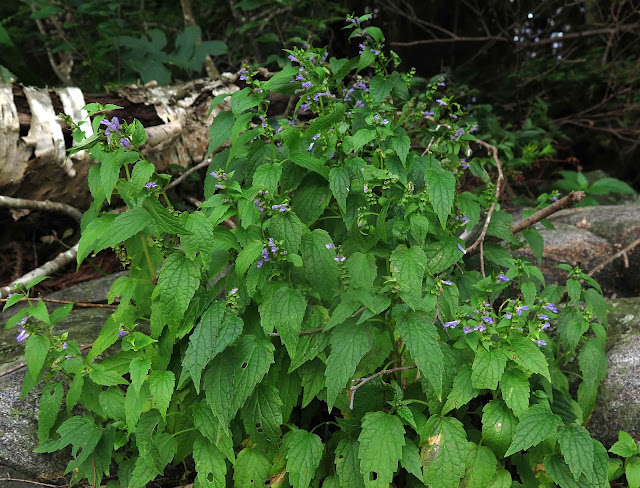At last! Woke up this morning to cool, dry air wafting in open windows instead of the suffocatingly steamy, already-sweltering sog we had suffered through for more than a week. That steamy sog kept me indoors next to the AC for much of last week, except for the day I ventured up to one of my favorite woodland ponds near Lake Desolation. At least when I'm paddling, I can throw water on my back to cool me off. And I planned to stay close to the deeply shaded, steep rocky banks of the north-facing shore.
I ventured out because it was time to check on some gorgeous shoreline flowers that should be blooming now. I feared for them, ever since massive flooding last September (caused by a culvert blockage) sent this pond's water levels clear up into the woods. An earlier paddle here this summer revealed that much of the shoreline vegetation looked drowned and dead. Would any have recovered, now that the flood has receded?
The mosses seemed OK, anyway. As did the patches of Bunchberry (Cornus canadensis), now bearing clusters of bright-red fruit. But I could find not a single ground-hugging white flower of Dalibarda, which normally would be spreading across these green mossy banks like stars in the sky.
Species that are happiest growing in swamps were doing okay. This Royal Fern (Osmunda regalis) looked gorgeous, bearing its plumes of cinnamon-brown spores, and the few stems of White Meadowsweet (Spiraea alba) sharing its bank looked none-the-worse for the drowning.
The flower I feared for most, called Narrow-leaved Gentian (Gentiana linearis), in past years bloomed along these banks by the thousands. My heart leaped up when I beheld a glimpse of royal blue down the shore, for royal blue is the color of the gentians' flowers. Ah, but 'twas just a clump of Marsh Skullcap (Scutellaria galericulata). Pretty enough, but not what I'd hoped to find.
Oho! There's one! There's two! Yay! Now I knew for sure that this flower would be in bloom at this location. But alas! These two lonely specimens, growing high up on the bank on the rootball of a flood-toppled tree, were the last I would see today. That was it: only
two Narrow-leaved Gentians along a shore where
thousands bloomed in past years.

Sigh! What a loss! As I scanned the shoreline all around the pond, these red-needled dead conifers attested that the gentians weren't the only plants affected by last year's flooding.
At least the true aquatic species were still thriving. I was glad to see flowering stalks protruding above the flaccid floating leaves of Narrow-leaved Bur-reed (Sparganium angustifolium).
Closer to shore, the slender stiffly upright leaves of another species of bur-reed (Sparganium americanum?) were aglitter with the sunlight flashing off the faceted transparent wings of hordes of damselflies.
It was very hard to get close enough for clear photos of the evasively flighty damselflies. But at least my camera's zoom caught the blue eyes, iridescent green thorax, and white band at the end of the abdomen to indicate that this pair could be Swamp Spreadwings (Lestes vigilax), especially since shoreline vegetation is their typical habitat.
Also, a thick stand of American Bur-reed is exactly the kind of place where Swamp Spreadwings prefer to mate and lay eggs.
Here's another insect I expect to find resting on bur-reed leaves, a beetle in the Chrysomelidae Family, of a genus, Donacia, that is difficult to pin down as to species. It looked especially beautiful with sunlight glinting off shiny wingcovers that resembled hammered copper.
Even though the Spreadwings seemed to dominate the bur-reeds, an occasional Bluet Damselfly (Enallagma sp.) found the shoreline vegetation a likely place to take a rest or keep vigil for insect prey.
An abundant patch of Goldenrod (Solidago sp.) near the canoe launch site attracted several species of butterflies, including this somewhat tattered Tiger Swallowtail.
A brief walk through the neighboring woods had me stopping to admire the bright-red fruit of a Painted Trillium (Trillium undulatum). But I soon hurried on to my car and its air conditioned comfort, since the sweat dripping into my eyes made it hard to see, and my glasses kept swimming off the end of my nose.
















3 comments:
...Cornus canadensis is one of my all time favorites.
Wow! Great pics! I feel like I took that walk with you! What a treat!
Sad about the gentians, a plant I've never found here -- but at least there's a seed source for the future.
Post a Comment